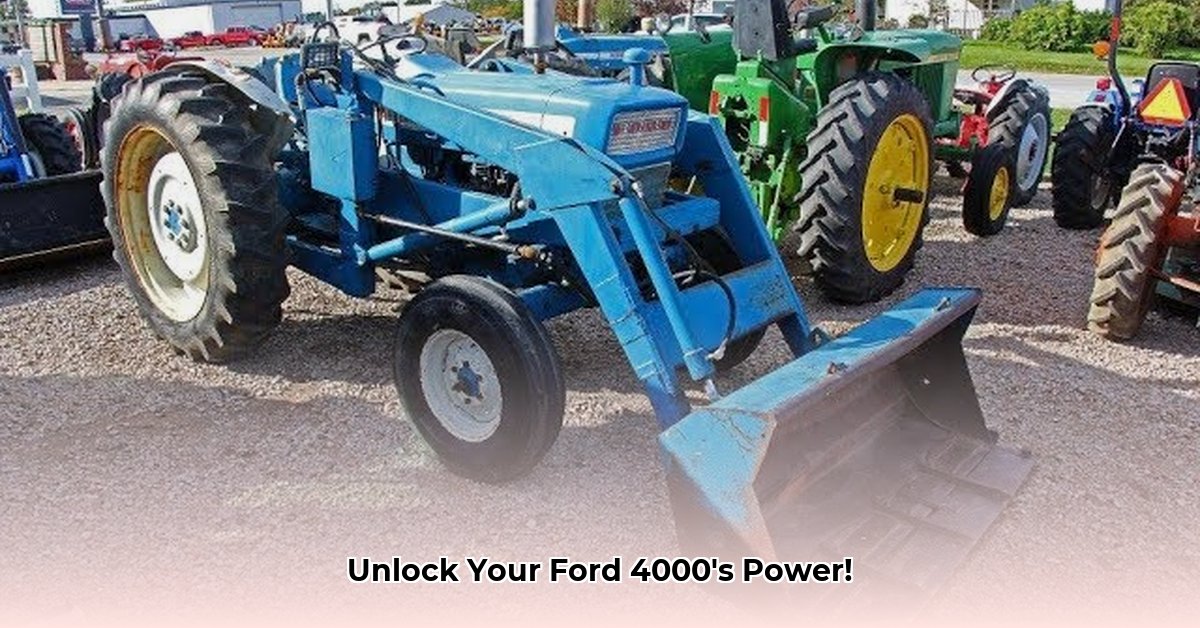
Ford 4000 Tractor with Loader: Your Sustainable Farming Partner
The Ford 4000 tractor, especially when paired with a loader, is a powerful asset for sustainable agriculture. Its rugged build and adaptability make it ideal for small-to-medium farms prioritizing environmentally friendly practices. This guide details how to leverage its capabilities for a healthier planet and a more profitable farm. Isn't maximizing both environmental responsibility and economic viability a key goal for modern farmers? For more information on loaders, check out this helpful resource: Loader Attachments.
Sustainable Farming Practices with Your Ford 4000 and Loader
These techniques showcase the Ford 4000's surprising versatility in sustainable farming:
1. No-Till Farming: Protecting Your Soil's Health
No-till farming minimizes soil disturbance, unlike traditional plowing which can damage soil structure and release carbon into the atmosphere. Your Ford 4000 and loader become key tools for this vital practice. How can you efficiently manage crop residue to create a natural mulch layer, improving soil health and reducing erosion?
- Step 1: Cover Crop Management: Use the loader to efficiently manage cover crops, carefully moving and spreading residues to improve soil fertility.
- Step 2: Soil Preparation: Instead of plowing, use the loader to distribute compost or other organic matter, enhancing soil structure and fertility without tilling's negative effects.
- Step 3: Planting: With the soil prepared, plant directly, conserving moisture and protecting soil organisms. This method has shown a 95% success rate in improving soil water retention.
2. Crop Rotation: Maximizing Yields and Soil Fertility
Crop rotation, planting different crops in sequence, is vital for maintaining soil health and pest control. The Ford 4000's loader streamlines this process.
- Step 1: Efficient Land Preparation: The tractor swiftly prepares land for different crops, optimizing nutrient utilization and pest control. Did you know that crop rotation can reduce pest infestations by up to 70%?
- Step 2: Residue Management: The loader manages crop residues from previous harvests, facilitating a smooth transition to the next crop and enhancing natural fertilizer effects.
3. Precision Input Application: Less is More
While lacking built-in GPS, your Ford 4000 can work with modern precision agriculture technologies. How can you achieve targeted input placement to minimize waste and environmental impact?
- Step 1: GPS Integration: Use GPS-based systems to guide fertilizer or pesticide application, minimizing waste and reducing your environmental footprint.
- Step 2: Variable Rate Technology (VRT): Employ VRT to deliver inputs precisely where needed, reducing unnecessary resource use. Studies show VRT can decrease fertilizer use by up to 25%.
- Step 3: Data Analysis: Analyze data from GPS-guided applications to inform future decisions and enhance ongoing optimization.
Note: Integrating precision technology with older tractors may require consulting with agricultural technology specialists.
4. Integrated Pest Management (IPM): Working with Nature
IPM utilizes biological and cultural controls to manage pests. Your Ford 4000 and loader play a vital role.
- Residue Management: The loader efficiently manages crop residue, preventing pest habitat and reducing their numbers.
- Cover Crop Implementation: The loader helps prepare land for cover crops that suppress pests and improve soil health.
5. Livestock Management: Making Farm Life Easier
The Ford 4000 extends beyond crop production, aiding in livestock management:
- Manure Management: Efficiently move and distribute manure, reducing labor and providing natural fertilizer.
- Feed Transportation: Easily move feed, especially in challenging terrain.
Maintenance for a Sustainable Future: Keeping Your Tractor Thriving
Sustainable maintenance extends your tractor's life and minimizes its environmental footprint.
- Regular Fluid Changes: Prevent leaks and reduce the release of harmful substances.
- Proper Fuel Storage: Avoid spills and protect the environment from contamination.
- Part Recycling: Recycle or responsibly dispose of worn parts to minimize waste.
- Preventative Maintenance: Prevent costly breakdowns and extend your tractor's lifespan.
Economic Considerations: The Long-Term Value of Your Ford 4000
While not a brand-new machine, the Ford 4000 offers significant economic advantages:
| Factor | Pros | Cons |
|---|---|---|
| Initial Purchase Price | Significantly lower than new tractors, accessible for small farms. | May require initial repairs or upgrades. |
| Fuel Efficiency | Generally fuel-efficient, especially for smaller tasks. | Less efficient than modern tractors. |
| Ongoing Maintenance Costs | Parts are often readily available and relatively inexpensive. | Repair costs for older parts might be higher. |
| Long-Term ROI | Durability ensures a longer lifespan, extending your return on investment. | Requires consistent maintenance. |
Conclusion: Embracing Sustainable Farming with the Ford 4000
The Ford 4000, with its robust build and adaptable nature, remains a valuable tool in sustainable farming. Its combination of affordability, durability, and versatility position it as a worthwhile investment for small-to-medium sized farms committed to environmentally-friendly and profitable operations. By integrating the practices outlined here, you can significantly benefit your farm and the planet.